Content
Published:
This is an archived release.
Managers take the job home
Half of all managers read and reply to work-related e-mails outside working hours on a daily basis. One out of five report that demands of the job often interfere with their home life.
| 1993 | 2003 | 2013 | |
|---|---|---|---|
| Does not have written employment contract, proportion of employees | 18 | 10 | 4 |
| In risk of losing job | 15 | 20 | 9 |
| Sickness absence lasting more than 14 days, average | 14 | 18 | 16 |
| Has been involved in accidents at work, last 12 months | 3 | 3 | 2 |
| Experience bad relationship between employees and management, often or time to time, employees | 42 | 32 | 31 |
| Exposed to hassle or teasing of workers, a couple of times in months el more | 3 | 2 | 2 |
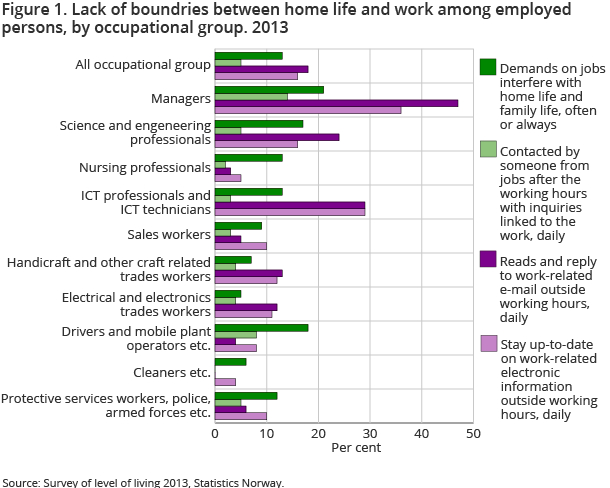
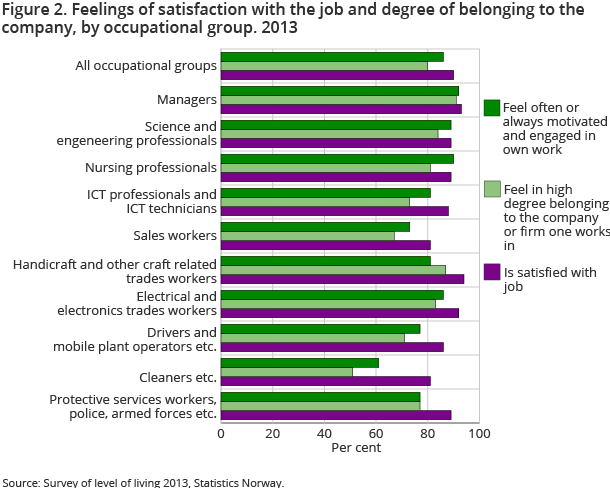
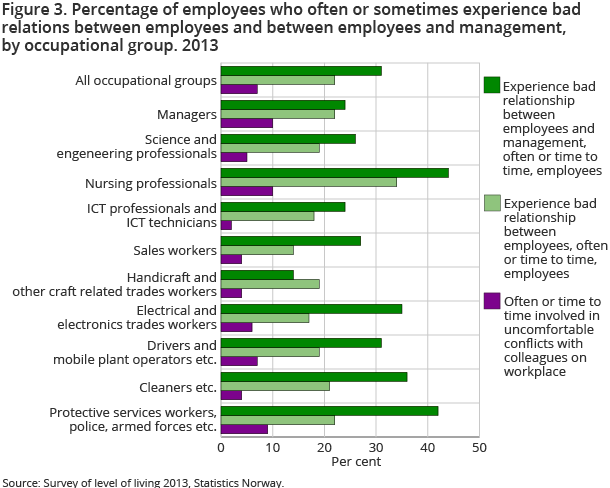
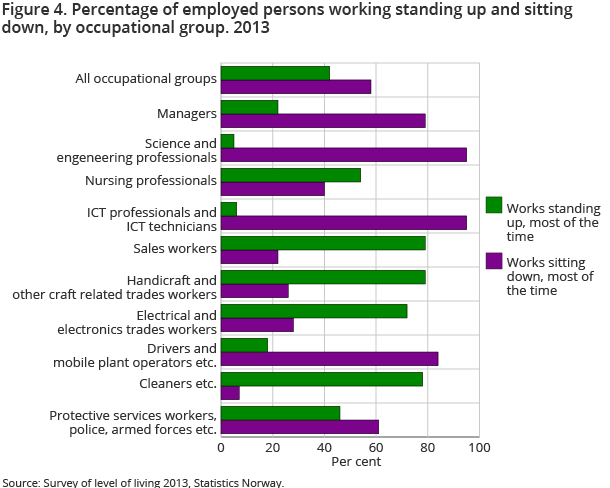
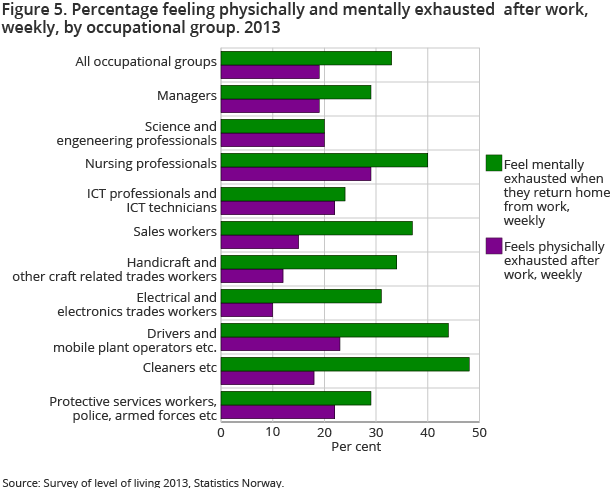
The boundaries between home life and the work place can sometimes be blurred, and employed persons take work home to varying degrees. Very few of employed persons are contacted by someone from work after working hours with requests and questions about work (5 per cent). It is more common to read and reply to work-related e-mails outside working hours, with 18 per cent doing this every day. Sixteen per cent also stay up-to-date on work-related electronic information, such as blogs, social media, roster information etc. on a daily basis. This is the first time data has been collected on this. No time series are therefore available.
Working outside of working hours is especially common among managers (see figure 1). Almost half of all managers read and reply to work-related e-mails on a daily basis outside working hours, and one out of three keep themselves posted on work-related electronic information. Managers also more often than other occupational groups report that demands of the job interfere with family life and home life. However, it is worth noting that a smaller share report that work interferes with home life than the share that deals with work outside working hours.
One in five cleaners temporary employed
Most employees have a permanent job, while 10 per cent have temporary employment. From 1989 to 1996, the share of temporarily employed persons went up, and the share has remained stable in the last few years. The highest share of temporarily employed persons is found among personal care workers and cleaners, with around 20 per cent in both groups.
At the same time, the share of employees that does not have a written employment contract has gone down, from 18 per cent in 1993 to 4 per cent in 2013. Since 2000, the share of employed persons who report being at risk of losing their job has gone down.
Motivated and engaged teachers
Another element of a person’s attachment to their job relates to their sense of belonging and motivation for the job. In general, most employed persons often or always feel motivated and engaged in their work. They feel a great sense of belonging to the company and are satisfied with their job (see figure 2). Employed persons in certain occupations that require higher education are especially motivated and engaged. Around 9 out of 10 teachers are often motivated.
One out of four never get feedback from their boss
Most employees receive feedback from their superiors on their work performance. However, one out of four employees say that they seldom or never get feedback on their performance. The share of employees that seldom gets feedback seems to have fallen since 2003. Fewer employees experience that their work achievements are seldom or never appreciated by their nearest boss.
Few conflicts among ICT professionals
Overall, 7 per cent of employed persons are involved in conflicts with colleagues at the work place. A larger share of employees experience a bad relationship between employees, without necessarily being involved themselves, at 22 per cent. More common are bad relationships between employees and management, either often or from time to time. Thirty-three per cent of employees report this form of bad relations. There seem to be fewer conflicts now than in 1989. Very few ICT professionals and ICT technicians are involved in conflicts (see figure 3).
Passive smoking among protective services workers, police, armed forces etc.
Over time, the share of employed persons exposed to passive smoking has gone down, from 12 per cent in 1989 to 1 per cent in 2013. In the same period, the share of daily smokers has gone down from 36 per cent to 16 per cent . In 2013, we found the highest share of employed persons being exposed to passive smoking among protective services workers, police, armed forces etc.
Sedentary work among science and engineering professionals
Half of all employed persons work sitting down, while 42 per cent work standing up. Business and administration professionals, ICT professionals and ICT technicians and science and engineering professionals have sedentary work, and almost all of them work sitting down (see figure 4), and 99 per cent work in front of a computer.
Exhausted nursing professionals
One in three employed persons feel physically exhausted after work on a weekly basis, while a smaller share, one in five, feel mentally exhausted when they return home from work. The share of persons who feel physically exhausted has been stable since the 1990s. 1 Nursing professionals feel both physically and mentally exhausted after work on a weekly basis (see figure 5).
1 A sentence about development in the proportion of mentally exhausted has been removed, as the figures are not comparable with previous years. The reason for this, is a change in the questions. Removed 13 August 2014.
Level of living survey on work environment 2013 Open and readClose
The level of living survey on the working environment has used a sample of 19 000 persons aged 16 to 66 from 2006 onwards whenever work environment has been the theme. This will give researchers greater opportunities to carry out detailed analyses of the work environment in different occupational groups and industries. In 2013, 10 875 persons responded to the survey, which amounts to 53.1 per cent of the sample. For more details about these statistics, see About the statistics.
Occupational groupsOpen and readClose
The division of employed persons into occupational groups is based on The Norwegian standard classification of occupations (Norwegian only). This is based on the International Standard Classification of Occupations (ISCO 08), developed by ILO. The standard is adjusted in the publishing of results from the level of living survey on working environment 2013,see Definitions in About the statistics.
Contact
-
Mari Lande With
E-mail: mari.lande.with@ssb.no
tel.: (+47) 98 43 36 65
-
Håvard Bergesen Dalen
E-mail: havard.dalen@ssb.no
tel.: (+47) 40 90 23 50
